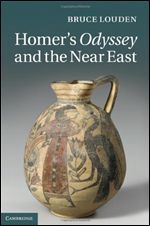 Bruce Louden is Professor in the Languages and Linguistics Department at the University of Texas at El Paso. He has written several works on Homeric literature and I am sharing here a small extract from his latest, Homer’s Odyssey and the Near East. Louden is a classicist, and what he writes here is similar to other recent studies that are beginning to notice how similar the gospels are to other classical and Near Eastern litearture. Many know of Dennis MacDonald’s work comparing Mark’s gospel to the Homeric epics, but there are several others along the same theme, including Thomas L. Thompsons’ The Messiah Myth, and Derek Murphy’s Jesus Potter Harry Christ.
Bruce Louden is Professor in the Languages and Linguistics Department at the University of Texas at El Paso. He has written several works on Homeric literature and I am sharing here a small extract from his latest, Homer’s Odyssey and the Near East. Louden is a classicist, and what he writes here is similar to other recent studies that are beginning to notice how similar the gospels are to other classical and Near Eastern litearture. Many know of Dennis MacDonald’s work comparing Mark’s gospel to the Homeric epics, but there are several others along the same theme, including Thomas L. Thompsons’ The Messiah Myth, and Derek Murphy’s Jesus Potter Harry Christ.
The following extract is singled out because it is an encapsulation of a broad overview of the role of Christ in the context of mythical heroes. The chapter explores much more detail, but some of that can be addressed in other posts. I have linked to Wikipedia articles most of the names from Greek myth for quick reference.
I would analyze the gospels’ overall depiction of Christ (as opposed to the specific sections with which we are here concerned) as a broad synthesis of five traditional types of mythical figures extant in ancient myth:
- The prophet who can perform miracles (Melampous; Elijah and Elishah in OT myth). [note: Mark repeatedly likens Christ to Elijah (Mark 6:15, 8:28, 9:4, 15:35-6)]
- The prophet who predicts the coming apocalypse (Theoklymenos in the Odyssey, and most OT prophets).
- The healer who can bring mortals back from death (Asclepius in Greek myth). [note: There is brief, elliptic mention of Asclepius in the Alcestis (Alc. 4, 124, 970). . . . ]
- The hero who can bring mortals back from death (Herakles in Greek myth, and Odysseus, as noted above). [note: The myth of Lazarus in John 11 is he same genre of myth as the Alcestis, with Christ in Herakles’ role, Lazarus in Alcestis’ and Mary in Admetos’.]
- A god, the son of god, who founds a new religion (Dionysus in Greek myth).
Christ’s treatment at the hands of the imperial and religious elites resembles Odysseus’ treatment at the hands of the suitors, and Dionysus’ treatment at the hands of Pentheus and, to a lesser extent, Cadmus in the Bacchae. Christ’s androgynous characterisitcs also evoke some of Dionysus’ defining qualities, as does his turning water into wine as hte first sign in John. Though contemporary audiences many regard Dionysus’ punishment of Pentheus and Thebes as excessively violent, the gospels’ depictions of Christ conclude with similar violence, though set in the future at the Day of Judgment, or Second Coming . . . (pp. 259-60)
Neil Godfrey
Latest posts by Neil Godfrey (see all)
- What Others have Written About Galatians (and Christian Origins) – Rudolf Steck - 2024-07-24 09:24:46 GMT+0000
- What Others have Written About Galatians – Alfred Loisy - 2024-07-17 22:13:19 GMT+0000
- What Others have Written About Galatians – Pierson and Naber - 2024-07-09 05:08:40 GMT+0000
If you enjoyed this post, please consider donating to Vridar. Thanks!
